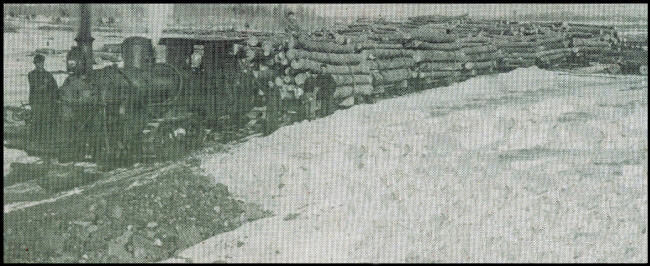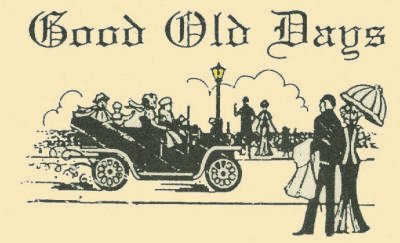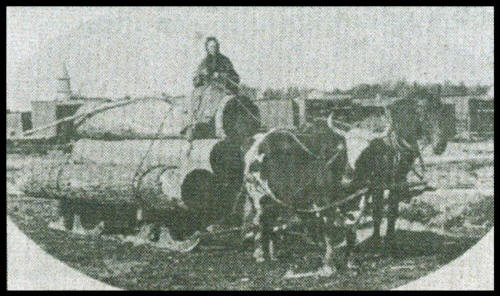|
|
|
Clark County Press, Neillsville, March 31, 2004, Page 14 Transcribed by Dolores (Mohr) Kenyon. Index of "Oldies" Articles
Compiled by Dee Zimmerman
Clark County News |
March 1869
For two or three seasons, there has been strife among the loggers in the pinery, to see who would haul the largest load of logs with one pair of horses. Two years ago, in a camp on Cunningham Creek, a load was drawn scaling 5,260 feet. This record was beaten a few days ago in McDonald’s camp by a load scaling 5,520 feet. On the 23rd of February, two horses in C. W. Carpenter’s camp, along the Black River hauled a distance of four miles, a load of logs that scaled 6,388 feet! The load was composed of seven logs, each 20 feet in length and of good sound timber. E. H. Carpenter, says if this record is to be beaten, his team of horse will do it by drawing a load of 10,000 feet.
A few days later, we received a communication from Mr. Wm. Welsh, of the Town of Loyal, which speaks of still a larger load being hauled. He says:
“On the first day of March, 1869, in the camp of Robert Ross, in the Town of Loyal, with James McDonald as foreman, one pair of horses weighing together 2,200 pounds, owned by F. Gallegly, hauled on a one-mile road, six sound logs measuring 7,375 feet! The logs were scaled out by T. B. Philpott, in presence of several disinterested persons who will vouch for the truth of this statement, if required.”
As for hauling 10,000 feet of logs, this will not be easily done by any horses in the pinery. But there is one certainly coming that will take the claim – the iron horse.
••••••••••
A man hailing from Portage County, arrived in town the other day with a bull hitched to a pung, in which the man was riding as unconcerned as a teamster behind a tote team. He guided the animal by means of lines fastened to a ring through the bull’s nose. Their destination was Loyal, Clark County.
••••••••••
Many of our citizens have united in a call upon Hon. James O’Neill, requesting him to become a candidate for office of Clark County Judge. In compliance with their request, he has consented to run. Mr. O’Neill has filled many offices of trust and responsibility with credit to himself and the county. In this position, we believe he will merit the same popular feeling, which has been shown him heretofore. We have heard of no other candidate for the office and presume there will be none. Considering Mr. O’Neill’s long residence in the county, his fairness and integrity, we know of no other upon whom the powers of this office can be more fittingly bestowed. The position was entirely unsought for by him. His consent to be a candidate was obtained only through the urgent request of numerous friends.
••••••••••
On the night of March 16, the stable in Capt. Thomas La Flesh’s camp on the East Fork, came very near being destroyed by fire. The origin of the fire was caused by a candle, which had been carelessly left burning, falling into the hay in one of the stalls. The stable is constructed with stalls on each side fronting a gangway running through the center. The fire occurred about twelve o’clock and before it was discovered, it had destroyed about two tons of hay and started burning the straw bedding around the horses. The fire was extinguished by the shakes on the roof that were burned so as to let the snow fall in upon the flames. It may seem incredible, but it is nevertheless a fact that only one horse was injured so that he was unfit for work the next day. The other horses were a little singed by the fire, but otherwise miraculously escaped serious injuries.
••••••••••
A law establishing a township system of school government was passed by the last Legislature. It is left to the discretion of the electors in each town to adopt the system or not. All persons particularly interested in the welfare of schools should examine the law closely and determine whether or not a change from the present system would be of advantage to the schools of their town. The law was undoubtedly suggested by other localities in the State, feeling the necessity of a change more than we do. Consequently, it is not enforced only where the change is especially desired. We believe the system would secure a better and more thorough management of schools. There would be more interest created and parents would be better satisfied in the education of their children. It is questionable whether a new country, like ours, could enjoy the greatest benefits of this new system.
March 1954
The dairy surplus problem was tackled on the community level, last Saturday, when 746 pints of milk were served by the Grace Lutheran Church’s Ladies Aid Society, at Nasonville.
The society served a lunch that day for the Marshfield Produce Association’s annual meeting. There was plenty of milk available; but not a drop of coffee. In addition, the society served an extra slice of cheese with the lunch.
Mrs. Orville Hansen, of Nasonville, is president of the society.
••••••••••
Mr. and Mrs. Ross Paulson, who were married 56 years ago last Tuesday, will have a family gathering at their home on Division Street, next Saturday evening.
••••••••••
Last week, educators of Neillsville, paid tribute to Supt. Donald E. Peters and John W. Perkins, agricultural instructor, who this year are completing 25 years of service in the local school system.
A dinner honoring the couple was given at Weber’s Fireplace and was attended by members of the Neillsville Board of Education, employees of the school system and a few others closely connected with the schools in the 25 years the two men have spent here.
Mrs. Otto Zaeske acted as toastmistress and called on Kenneth Olson, president of the school board, to speak. Mr. Olson presented each man with a gift from the board. Ivan Lauscher, principal of the high school, presented gifts to them from their co-workers. Frank E. Brown, a member of the school board at the time Mr. Peters and Mr. Perkins were hired also spoke.
Miss Daphne Beeckler gave two appropriate readings; Earl Ruedy reminisced about several amusing experiences of the faculty members and C. Scott Hunsberger sang the solo, “Without a Song.” Mr. Peters and Mr. Perkins each responded with short talks.
••••••••••
Residents of Neillsville and many interested outsiders will get their first formal inspection of the city’s new $187,000 water purification plant at an Open House, this Saturday and Sunday.
From 9 a.m. until 9 p.m. on Saturday, Supt. William Wilsman will conduct tours of the plant, every hour, on the hour. Sunday, similar tours will be conducted from 9 a.m. until 5 p.m.
The new utility was a long time in coming; but, in the opinion of Mr. Wilsman, “Neillsville has one of the finest water plants in this section of the country.”
••••••••••
Preparations for the forth-coming “brick sale,” through which it is hoped that the need for borrowing to complete the new $500,000 Memorial Hospital here, were advanced Monday night at a meeting attended by approximately 20 persons.
At this meeting, it also was announced that the Memorial Hospital had received a contribution of $15,000. This is the largest single contribution to date and brings the amount to approximately $225,000. The amount remaining to be raised locally is about $75,000.
In discussing the forthcoming “brick sale” campaign, the Rev. Benjamin Stucki revealed that the mild weather and rapid progress of the hospital building has outstripped the ready cash on hand. Thus, there is urgency in securing cash. He pointed out, however, that this area had done a most remarkable job in financing the project, with approximately 60 percent of the pledges already turned in to cash in less than a year.
Money for the Memorial Hospital can be secured through borrowing and arrangements for that type of financing can be made, Rev. Stucki and Dr. M. V. Overman pointed out at the meeting. But the net effect of borrowing will be to add to the financial burden, which should be avoided if possible.
Thus, the brick sale, the idea of which is to sell each of the 63,000 bricks being used in the hospital at $1.00 each; preferably, these sales are to be made in multiple quantities to 10 and upward of each person.
••••••••••
Irving Gower has purchased from Albert Matthews, a small acreage of land adjoining his farm, on the east side, near Granton. The small building on the place will be torn down and the lumber used for other purposes.
With the building gone, the last evidence that this site was once, the scene of great activity will disappear. Few people, in the community, know that on this land the first saw mill in this area was established.
This land was purchased by Charles Renne in 1874, Renne being its first owner. In 1879 he sold it to John Mason. The land, which can be reached by a road, lies about one-fourth mile south from Windfall Corners and on the north bank of the O’Neill Creek. The saw mill was built, as was a large house, where Mr. and Mrs. Mason lived and operated a boarding house for the mill hands. Farmers and their sons found winter employment there, but some lived too far away to put in a 10-hour work day and cover the distance on foot to the mill and back twice a day.
The abstract shows that such lumbermen as Jones Tompkins and John MacMillan owned the land. Mr. Mason sawed the timber purchased from the farmers who were clearing the land in this area. The saw mill was in full operation until the coming of the railroad in 1890 when a saw mill was built by other interests closer to the railroad tracks for easy transportation of lumber.
It was on the old mill-pond by the Mason mill where the young folks gathered for their skating parties.
The ownership of this land was once in the hands of John Fuller, who in turn sold it to Dr. R. R. Rath. The original buildings had been destroyed by fire and Dr. Rath built a small barn and a small house before selling it to the last owner, Albert Matthews.
••••••••••
Gorman Cooperative Dairy Co. sold its milk truck recently to Robert Bogdonovich, who expects to haul milk for them beginning March 16. The milk route is about 40 miles long.
••••••••••
Two farms owned and operated, in the Town of Pine Valley, by Charles F. Brooks and his son, William R., were sold at foreclosure auction in the courthouse to Herman North for $12,000, on Friday afternoon. The larger of the two farms is 240 acres and is better known hereabouts as the “old Borde farm” near Ross’ Eddy. The other property consists of 80 acres and was the old Foote farm, a mile south of the fairgrounds. Both farms have substantial buildings.
••••••••••
Completion of one of the most successful small church fundraising campaigns ever conducted was announced at a “Victory dinner” at Our Savior’s Lutheran Church, Greenwood last week.
As a result, plans for a new church building for the congregation have been adopted and construction is scheduled to start in the spring. The site chosen is located just west of Highway 73 and north of County Trunk G, on Greenwood’s north city limits.
The church building will be of two stories and modern design. It will be constructed to include a sanctuary with seating capacity of 350, with fellowship and Sunday school department on the lower floor.
The campaign for funds was a whirl-wind affair, conducted within the membership of the church by professional fund-raisers. According to M. S. Egge, the pastor, “Statistics show this to be one of the most successful small church drives in the United States for the past 12 months. An Episcopal Church in New York State ran proportionately higher.”
“Members were frankly grateful for the emphasis which was placed on Christian faith, prayer and the need for the individual Christian to concentrate on giving rather than thinking on the needs of the church,” the Rev. Ebbe commented.
The drive was launched at a Loyalty dinner, at which the congregation was made aware of its purpose and goal.
Members of the campaign committee included: John D. Wuethrich, chairman; Dr. William Olson, honorary chairman; Palmer Vinger, special gifts secretary and Russell Mead, financial secretary. Canvassers were: Harry Gordee, Robert Ramin, William Dallman, Lyle Verhulst, Arendt Danielson, Earl Caliebe, Louis Behrens, Cecil Lombard, Aage Neilsen, Carl Turnquist, Ralph Ystad, Melven Alperstett, Kenneth Hium and Art Turnquist.
¤¤¤¤¤¤¤¤¤¤¤¤
The old and new way of hauling logs, at the turn of the century,
shown in these photos taken at Medford, Wisconsin.
The 1900 photo shows a bobsled loaded with large logs being pulled by an oxen and one horse, making up a team.

The 1906 photo records the introduction of the “iron horse,” a locomotive, which could pull several bobsleds hauling cut logs.
(The photos were originally those of Jack Fahey who grew up in the Greenwood area)


